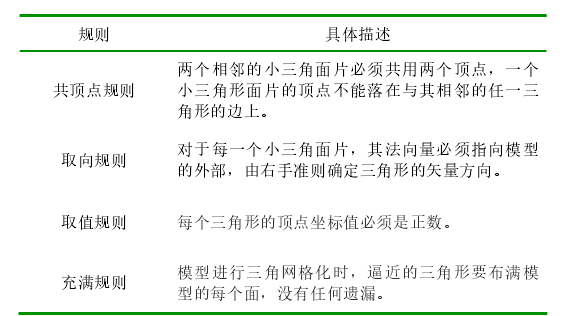基于SLS技术的旋转型快速 3D打印系统的扫描路径及分层算法等成型工艺仿真与优化毕业论文
2020-04-13 11:23:25
摘 要
快速制造(RP)技术是目前最为前沿的制造技术之一,而在众多RP方法之中,快速烧结(SLS)技术又是其中最受关注的一种。分层切片软件作为其灵魂,成为了CAD到RP的处理接口。
本文主要研究了SLS分层切片算法常用的文件格式STL(STereoLithography)格式,设计了从STL文件中提取模型信息的方法,该方法可以识别某个文件是不是STL文件以及是何种STL文件。然后研究了基于STL文件的切片算法,该算法包括轮廓生成,划分打印区域,标记打印区域,路径规划等内容。接着用python语言实现了该算法,可以实现输入某个STL文件,输出一系列表示每个切平面的截面轮廓的svg(位图)格式的图像。
最后使用开源切片软件slic3r对相同的模型进行切片,通过与该算法结果进行对比,发现轮廓基本吻合。已经具备了切片算法的基本功能,为后续开发出更加完善的切片算法打下基础。
本文的算法在编写时具有两个创新点:第一是使用了目前最流行的python语言,该语言简洁、易懂、易读且易于维护,但是较少运用在切片软件的编写中,本文运用python实现该算法不失为一种尝试;第二是在进行线段重组时采取了一种新的办法,许多文献在进行线段重组时需要提前标记好线段的起点和终点,即线段有方向性,本文提出了一种不需要确定线段方向的重组算法,提高了效率。
关键词:选择性激光烧结;3D分层算法;3D打印;SLS
Abstract
Rapid manufacturing (RP) technology is currently one of the most cutting-edge manufacturing technologies. Of the many RP methods, rapid sintering (SLS) technology is one of the most concerned. Layered slice software, as its soul, has become the processing interface from CAD to RP.
This paper mainly studies the STL (STereoLithography) format commonly used in SLS layered algorithms and designs a method for extracting model information from STL files. This method can identify whether a file is an STL file and what kind of STL file it is. Then the slicing algorithm based on the STL file is studied. The algorithm includes the contour generation, the division of the print area, the marking of the print area, and the path planning. Then the algorithm is implemented in Python language, which can realize the input of a STL file and output a series of images in the svg (bitmap) format representing the cross-sectional profile of each tangent plane.
Finally, the same model was sliced using the open source slicing software slic3r. Compared with the results of the algorithm, it was found that the contours were basically consistent. Already have the basic function of the slice algorithm, lay the foundation for the subsequent development of a more complete slice algorithm.
The algorithm of this paper has two innovations when it is written: The first is the use of the most popular python language. The language is concise, easy to understand, easy to read and easy to maintain, but it is less used in the preparation of slicing software. Python implementation of this algorithm is an attempt; the second is to take a new approach when line segment reorganization, many documents in the line segment reorganization need to mark the beginning and end of the line segment in advance, that is, the line segment has directionality, this paper proposes a recombination algorithm that does not need to determine the direction of the line segmentand improves the efficiency.
Key Words:Selective laser sintering; 3D slicing algorithm; 3D printing; SLS
目录
摘要 Ⅰ
Abstract Ⅱ
- 绪论 1
1.1 研究背景 1
1.2SLS技术研究现状 2
1.2.1 SLS技术原理 2
1.2.2 SLS技术研究现状 3
1.2.3 SLS技术应用前景 3
1.3切片技术研究现状 4
1.3.1RP技术的数据接口 4
1.3.2 数据处理过程 5
1.3.3 切片软件研究现状 5
1.4论文的组织结构 6
第2章STL文件介绍及ST文件中模型信息提取 7
2.1STL文件格式介绍 7
2.1.1ASCII文件格式 9
2.1.2BINARY(二进制)文件格式 9
2.2STL文件的读入与分析 10
第3章 几种基于STL模型的分层算法研究 13
3.1轮廓生成 14
3.1.1交点情况分析 14
3.1.2交点计算 16
3.1.3线段组合 16
3.1.4线段冗余处理 17
3.2 划分打印区域 18
3.3 标记填充区域 20
3.3.1打印区域的逻辑运算 20
3.3.2激光光斑的半径补偿 21
3.4 路径规划 21
3.5 生成G代码 23
第4章 简单分层算法的python实现 24
4.1 文件的结构 24
4.2 类介绍 24
4.2.1Vector3类 25
4.2.2Normal类 25
4.2.3Edge类 26
4.2.4Triangle类 26
4.2.5Model3D类 27
4.2.6STLModel类 28
4.3 主函数介绍 28
第5章 分层算法测试 30
5.1 自制算法试验结果 30
5.2 开源分层软件slic3r试验结果 31
5.3 分析结论 32
第6章经济性分析和总结展望 33
6.1 经济性分析 33
6.2 总结和展望 33
6.2.1 总结 33
6.2.2 展望 33
参考文献 35
致谢 36
第1章 绪论
·1.1研究背景
随着科技的发展和提高,人类的产品需要从原来的单一化、标准化渐渐转变为个性化、多样化,故以往的大批量生产方式逐渐无法满足需求。上世纪80年代开始,计算机技术的迅速的发展推进了CAD和CAM技术的迅猛发展,因此,快速成型(RP)技术便应运而生。
RP技术首先出现于1980年代。这门集合了激光加工技术、计算机辅助设计技术、材料科学技术以及数控技术的新型技术与传统制造业的工艺不同,后者主要工艺是去除材料和材料变形,但RP技术不需要模具、夹具便可以迅速制造出符合人们需要的实体零件,从而使产品的开发时间得到降低。因此,RP 技术的竞争力与日俱增并有希望成为未来的主要制造技术。具体制造方法如下图。

图 1.1RP技术原理
目前RP技术有十多种类型,主要有:立体光固化SLA;叠层制造 LOM;选择性激光烧结 SLS;三维印刷 3D - P;熔融沉积造型 FDM等。不同的RP方法具有不同的特点,在这些方法中,选择性激光烧结(SLS)发展速度最快且最受关注。该技术不但能够制造出用于铸造的原型,还可以制造出强度很高的金属件,这些零件甚至可以直接用作功能件。有着许多优点的SLS技术在先进制造业中起着越来越重要的作用。[1]
几种广泛应用的RP技术的原理:
(1)立体光固化SLA:最早得以实现的RP技术,使用液态光敏树脂为原材料,这种材料当被激光照射到时将会被固化,当固化完一层后再继续固化下一层,层层叠加最后形成三维实体。一般被用来制造模具或原型,用于熔模铸造中。
(2)选择性激光烧结SLS:在固体粉末层上使用激光沿着特定的路径烧结固体粉末,烧结完一层后下降一层,依次叠加,最后形成特定的零件外形。其工艺流程有:建模、数据处理、铺展固体粉末、进行烧结以及后处理等。主要用来制造金属零件,意义重大。
(3)叠层制造LOM:制造原材料是片状材料,先通过分层算法得到每层的轮廓,再用激光把纸张切割出相同的轮廓,这些纸张背后涂有热熔胶,然后将刚刚的纸张叠上去,然后通过装置施加压力将其粘合,然后重复上述操作,最后形成三维实体。
以上是毕业论文大纲或资料介绍,该课题完整毕业论文、开题报告、任务书、程序设计、图纸设计等资料请添加微信获取,微信号:bysjorg。
相关图片展示:











